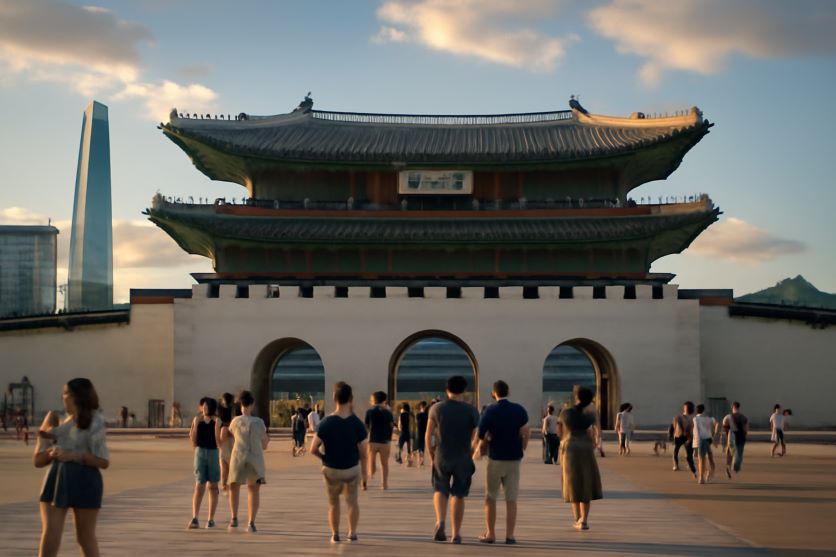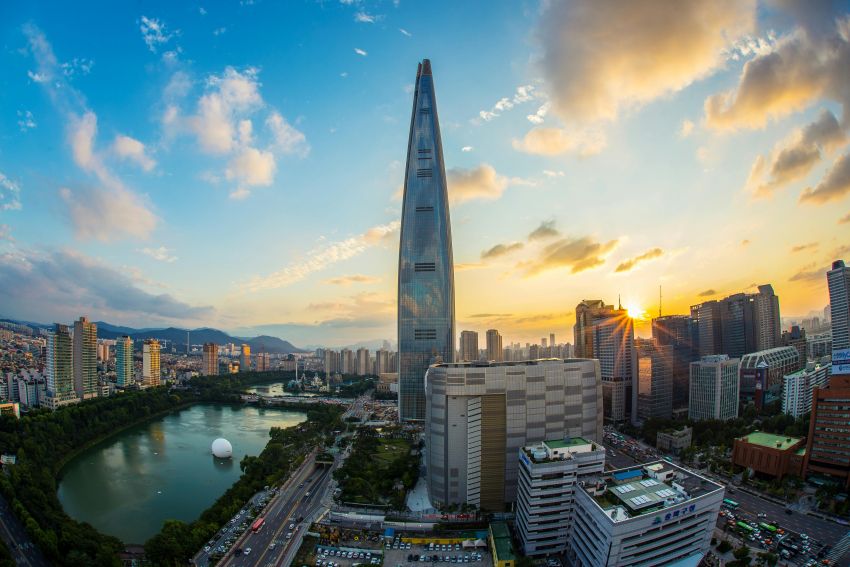.jpg/alternates/LANDSCAPE_480/0-1.%20Jeonju%20Hanok%20Village%203.jpg)
.jpg/alternates/LANDSCAPE_910/0-1.%20Jeonju%20Hanok%20Village%203.jpg)
Jeonju Hanok Village is one of the top tourist attractions for travelers seeking to explore rich Korean culture and flavors. With over 700 traditional hanok houses, Jeonju has one of the largest grouping of these antique buildings. This destination transports visitors into old Korea with its beautiful views and plenty of shops to try on traditional hanbok clothing, sip on tea and learn about traditional medicine.
Jeonju City is the ancestral home of the Yi family, who ruled the Joseon Dynasty for more than 500 years. Within the village, you can find many beautiful historical sites, including Gyeonggijeon Shrine. Jeonju is also known for its famous local dishes, including bibimbap and delicious street foods. Moreover, Jeonju is easily accessible thanks to various transportation options including trains (KTX, Mugunghwa and Saemaeul) and intercity buses, making it an ideal day trip or backpacking spot among locals.
Whether you’re a history enthusiast, foodie, or simply love capturing stunning photos, Jeonju guarantees an enjoyable experience for travelers. Here are the top 4 activities you must try in Jeonju Hanok Village.
For a transportation guide, map and more tips on traveling Jeonju Hanok Village, visit their official website.
Renting hanbok
Donning hanbok, Korea’s traditional attire at hanok villages or historical sites, is a huge travel trend in Korea. Especially in Jeonju Hanok Village, it’s a must-do activity for capturing fascinating photos with the neighboring traditional homes as a backdrop.
Women can transform into Joseon princesses or noblewomen and men can be kings, warriors, and scholars. Wearing this beautiful attire can make your trip truly special. You can choose either traditional hanbok or modern hanbok, which is more fancy and colorful. Pick your favorite color and pattern of hanbok and step back into the Joseon Dynasty in the hanok village!
Hanbok Rental at Hanboknam Jeonju
Hanboknam is a famous hanbok rental shop franchise located near most hanok villages and historical sites popular. You can also find their shop in Jeonju Hanok Village. Rental prices vary depending on the hanbok style and duration, but many go for a 2-hour rental, typically costing between 10,000 to 20,000 won. Traditional accessories and purses are available for an additional fee. The staff can assist with hairstyling to complement the hanbok with hair accessories that may require you to pay an additional 2,000 to 3,000 won.
-Address: 54-1 Eunhaeng-ro, Wansan-gu, Jeonju-si, Jeollabuk-do
(한복남 전주한옥마을점)
-Hours: 9:30 a.m. – 8 p.m.
-Contact: 010-6424-1739
-Price: 7,000 won – 35,000 won (one hour to full-day rental)
Eating bibimbap
Jeonju’s bibimbap is the most famous version of this beloved rice-and-vegetable dish. That’s because Jeonju’s bibimbap has diverse ingredients and shows the harmony of five colors – green, red, yellow, white and black – which signify five elements of the universe.
Bibimbap is a Korean dish consisting of rice topped with a variety of seasoned vegetables, eggs, meat, and red pepper paste sauce. The fantastic color harmony of the ingredients makes the dish visually stunning. Once all the ingredients are prepared, mix them together with a spoon. You can adjust the level of spiciness by adding more red pepper paste sauce.
Try bibimbap at Jeonju Manwol
This restaurant offers delectable Korean dishes specializing in Jeonju bibimbap, beef pancakes, and pork galbi inside a traditional house. Each dish not only boasts beautiful colors, but also offers an authentic Korean taste. As with many restaurants in Korea, side dishes with free refills are also included. So, if you want more, don’t hesitate to ask!
-Address: 3 Manwol, Choi Myeonghui-gil, Wansan-gu, Jeonju-si, Jeollabuk-do (만월 전주한옥마을점)
-Hours: 9 a.m. – 9 p.m.
-Contact: 063-231-3800
-Price: 11,000 won – 17,000 won per dish
Savoring street food
Street food is an exciting part of the Korean travel experience! Of course, you can find numerous tasty street foods in Jeonju Hanok Village. While you wander through the traditional hanok houses, you’ll be tempted by cheese-filled bread, fried tornado potatoes, corn dogs, and refreshing fruit juices. So, make sure to save some space for snacking.
Visiting beautiful historical sites
In Jeonju Hanok Village, not only are there entire districts of hanok buildings, but also many heritage sites. While exploring the village, stop by these beautiful historical spots to learn more about Korea. These attractions are also wonderful photo spots and are all located within walking distance from the village. To navigate, download the tour map from the Jeonju Hanok Village website above.
Gyeonggijeon Shrine
Gyeonggijeon Shrine houses a portrait of King Taejo, the founding ruler of the Joseon Dynasty. The atmosphere of Gyeonggijeon is serene with its profound traditional beauty and its bamboo grove is a famous photo zone.
-Hours: 9 a.m. – 6 p.m.
-Admission: 1,000 won – 3,000 won
-gyeonggijeon.jpg/alternates/LANDSCAPE_910/4-2.%20BY%20Jeonju%20Hanok%20Village%20Gyeonggijeon.jpg)
Gyeonggijeon (PHoto courtesy of Jeonju Hanok Village)
Jeonju Hyanggyo (Local Confucian School)
Established as an educational institution during the Joseon Dynasty for ancestral rites and education, Jeonju Hyanggyo features a 400-year-old gingko tree in front of the main hall, which is famous for its autumn foliage.
-Hours: 9 a.m. – 6 p.m. (Closed on Mondays)
-jeonju-hyanggyo.jpg/alternates/LANDSCAPE_910/4-2.%20BY%20Jeonju%20Hanok%20Village%20Jeonju%20Hyanggyo.jpg)
Jeonju Hyanggyo (PHoto courtesy of Jeonju Hanok Village)
Jeondong Catholic Cathedral
Built to commemorate the martyrs of the Catholic faith during the persecution of Catholics in the Joseon Dynasty, this cathedral stands as a landmark of Jeonju, visible from anywhere in the Hanok Village.
-Hours: 9 a.m. – 5 p.m.
-jeondong.jpg/alternates/LANDSCAPE_910/4-2.%20BY%20Jeonju%20Hanok%20Village%20Jeondong.jpg)
Jeondong (PHoto courtesy of Jeonju Hanok Village)
Jeonju Omokdae
Omokdae sits at top of the highest hill in Jeonju and is where Yi Seong-gye celebrated a victory against Japanese invaders. The area offers a panoramic view of the Jeonju Hanok Village, blending urban and traditional scenery. Also, it’s conveniently located on the way to Jaman Mural Village, so don’t miss to stop by these places!
Hanok (한옥) – Traditional Korean houses
Hanok, a traditional style of Korean houses, has two main types: tile-roofed, where noblemen dwelled, and thatch-roofed, where commoners resided in the past. When referring to “Hanok” in modern days, it’s usually associated with traditional houses of the tile-roofed type. Hanok continues to be cherished even today, and many locals live in preserved historic Hanok villages.
Hanok’s unique architecture used science modern at the time to heat homes in the winter and cool them in the summer. For instance, the ondol heating system warmed the floors and the interior of the home, while the wooden floors helped residents cope with the summer heat. The homes were also constructed with eco-friendly materials like clay, wood, stone, and traditional paper called hanji to help with air circulation and durability. Even today, the features of hanok continue to influence aspects of modern life, like heated flooring, floor-sitting culture, jjimjilbang (Korean spa), and restaurants with floor seating.
Hanbok (한복) – Traditional Korean clothing
Hanbok is traditional attire worn in Korea since ancient times. However, the Joseon Dynasty style of hanbok is the one widely recognized today. Koreans still wear hanbok to this day for significant occasions such as traditional holidays, weddings, and important family events.
Hanbok features its distinctive beauty with diverse patterns and colors, which are often very bold. Color coordination between the top and bottom is key. The top consists of a jacket called jeogori (저고리) and for the bottoms, men wear trousers and women wear long voluminous skirts. The colors and designs can often symbolize social and marriage statuses.
Today, hanbok has evolved into various styles blending traditional style with modern twists. Wearing hanbok at historical sites is a beloved activity among locals and tourists. Renting a hanbok is very affordable, and it is highly recommended to try wearing them in spring or fall.
Best historical sites to experience both hanok and hanbok
-Gyeongbokgung Palace & Bukchon Hanok Village (Seoul)
-Jeonju Hanok Village
-Andong Hahoe Folk Village
-Gyeongju Gyochon Traditional Village & other ancient sites
Where to buy Hanbok?
Gwangjang Market in Seoul is home to the biggest hanbok market in Korea. It offers high-quality products at more affordable prices. You can find a wide variety of Hanbok styles available and even order a customized Hanbok as well.
link

.jpg/alternates/LANDSCAPE_910/3.%20Street%20food%201.jpg)
.jpg/alternates/LANDSCAPE_910/3.%20Street%20food%203.jpg)
-omokdae.png/alternates/LANDSCAPE_910/4-2.%20BY%20Jeonju%20Hanok%20Village%20Omokdae.png)
-panoramic-view-at-omokdae-(1).jpg/alternates/LANDSCAPE_910/4-2.%20BY%20Jeonju%20Hanok%20Village%20Panoramic%20view%20at%20Omokdae%201.jpg)






